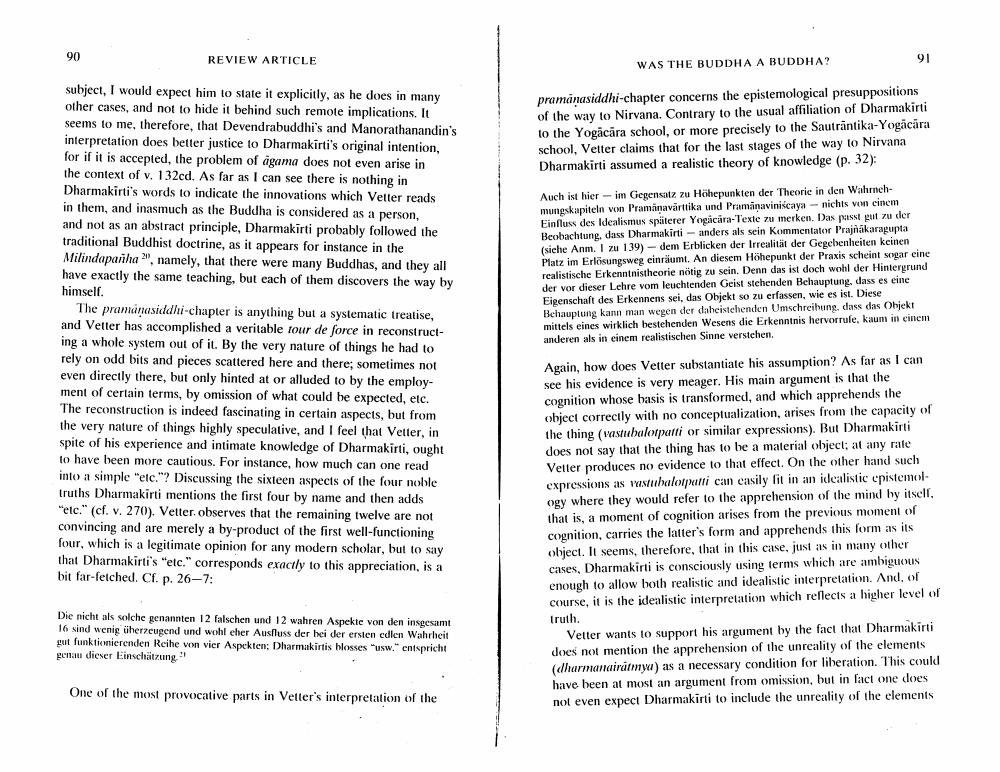Book Title: was The Buddha A Buddha Author(s): Eli Franco Publisher: Eli Franco View full book textPage 6
________________ 90 REVIEW ARTICLE subject, I would expect him to state it explicitly, as he does in many other cases, and not to hide it behind such remote implications. It seems to me, therefore, that Devendrabuddhi's and Manorathanandin's interpretation does better justice to Dharmakirti's original intention, for if it is accepted, the problem of agama does not even arise in the context of v. 132cd. As far as I can see there is nothing in Dharmakirti's words to indicate the innovations which Vetter reads in them, and inasmuch as the Buddha is considered as a person, and not as an abstract principle, Dharmakirti probably followed the traditional Buddhist doctrine, as it appears for instance in the Milindapanha 2", namely, that there were many Buddhas, and they all have exactly the same teaching, but each of them discovers the way by himself. The pramanasiddhi-chapter is anything but a systematic treatise, and Vetter has accomplished a veritable tour de force in reconstructing a whole system out of it. By the very nature of things he had to rely on odd bits and pieces scattered here and there; sometimes not even directly there, but only hinted at or alluded to by the employment of certain terms, by omission of what could be expected, etc. The reconstruction is indeed fascinating in certain aspects, but from the very nature of things highly speculative, and I feel that Vetter, in spite of his experience and intimate knowledge of Dharmakirti, ought to have been more cautious. For instance, how much can one read into a simple "etc."? Discussing the sixteen aspects of the four noble truths Dharmakirti mentions the first four by name and then adds "etc." (cf. v. 270). Vetter. observes that the remaining twelve are not convincing and are merely a by-product of the first well-functioning four, which is a legitimate opinion for any modern scholar, but to say that Dharmakirti's "etc." corresponds exactly to this appreciation, is a bit far-fetched. Cf. p. 26-7: Die nicht als solche genannten 12 falschen und 12 wahren Aspekte von den insgesamt 16 sind wenig überzeugend und wohl eher Ausfluss der bei der ersten edlen Wahrheit gut funktionierenden Reihe von vier Aspekten: Dharmakirtis blosses "usw." entspricht genau dieser Einschätzung." One of the most provocative parts in Vetter's interpretation of the WAS THE BUDDHA A BUDDHA? 91 pramānasiddhi-chapter concerns the epistemological presuppositions of the way to Nirvana. Contrary to the usual affiliation of Dharmakirti to the Yogacara school, or more precisely to the Sauträntika-Yogacara school, Vetter claims that for the last stages of the way to Nirvana Dharmakirti assumed a realistic theory of knowledge (p. 32): Auch ist hier im Gegensatz zu Höhepunkten der Theorie in den Wahrnehmungskapiteln von Pramanavärttika und Pramanaviniscaya - nichts von einem Einfluss des Idealismus späterer Yogacara-Texte zu merken. Das passt gut zu der Beobachtung, dass Dharmakirti - anders als sein Kommentator Prajñākaragupta (siehe Anm. I zu 139) dem Erblicken der Irrealität der Gegebenheiten keinen Platz im Erlösungsweg einräumt. An diesem Höhepunkt der Praxis scheint sogar eine realistische Erkenntnistheorie nötig zu sein. Denn das ist doch wohl der Hintergrund der vor dieser Lehre vom leuchtenden Geist stehenden Behauptung, dass es eine Eigenschaft des Erkennens sei, das Objekt so zu erfassen, wie es ist. Diese Behauptung kann man wegen der daheistehenden Umschreibung, dass das Objekt mittels eines wirklich bestehenden Wesens die Erkenntnis hervorrufe, kaum in cinem anderen als in einem realistischen Sinne verstehen. - Again, how does Vetter substantiate his assumption? As far as I can see his evidence is very meager. His main argument is that the cognition whose basis is transformed, and which apprehends the object correctly with no conceptualization, arises from the capacity of the thing (vastubalotpatti or similar expressions). But Dharmakirti does not say that the thing has to be a material object; at any rate Vetter produces no evidence to that effect. On the other hand such expressions as vastubalotpatti can easily fit in an idealistic epistemology where they would refer to the apprehension of the mind by itself. that is, a moment of cognition arises from the previous moment of cognition, carries the latter's form and apprehends this form as its object. It seems, therefore, that in this case, just as in many other cases, Dharmakirti is consciously using terms which are ambiguous enough to allow both realistic and idealistic interpretation. And, of course, it is the idealistic interpretation which reflects a higher level of truth. Vetter wants to support his argument by the fact that Dharmakirti does not mention the apprehension of the unreality of the elements (dharmanairatmya) as a necessary condition for liberation. This could have been at most an argument from omission, but in fact one does not even expect Dharmakirti to include the unreality of the elementsPage Navigation
1 ... 4 5 6 7 8 9 10
